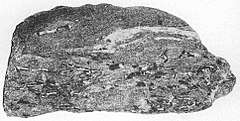Chickies Formation
| Chickies Formation Stratigraphic range: Cambrian | |
|---|---|
| Type | metamorphic |
| Sub-units | Hellam Conglomerate Member |
| Lithology | |
| Primary | quartzite |
| Other | slate, schist |
| Location | |
| Region | Mid-Atlantic United States |
| Country |
|
| Extent | Pennsylvania, New Jersey, Maryland |
| Type section | |
| Named for | Chickies Rock |
| Named by | J. Peter Lesley, 1876 |


The Cambrian Chickies Formation is a mapped bedrock unit in Pennsylvania, New Jersey, and Maryland. It is named for Chickies Rock, north of Columbia, Pennsylvania along the Susquehanna River.
Description
The Chickies Formation is described as a light-gray to white, hard, massive quartzite and quartz schist with thin interbedded dark slate at the top. Included at the base is the Hellam Conglomerate Member. It is a rare metamorphic rock that has fossils; Skolithos is found throughout the formation.[1]
Depositional age
Relative age dating places the Chickies in the Lower Cambrian Period, deposited between 542 and 520 million years ago (±2 million years).[2]
Economic uses
The Chickies is quarried as a building stone and for aggregate. The stone used to build the restrooms at Valley Forge National Historical Park is Chickies quartzite.[3]
See also
References
- ↑ Berg, T.M., Edmunds, W.E., Geyer, A.R. and others, compilers, (1980). Geologic Map of Pennsylvania: Pennsylvania Geologic Survey, Map 1, scale 1:250,000.
- ↑ Blackmer, G.C., (2005). Preliminary Bedrock Geologic Map of a Portion of the Wilmington 30- by 60-Minute Quadrangle, Southeastern Pennsylvania. Pennsylvania Geologic Survey, Open-File Report OFBM-05-01.0.
- ↑ http://www.dcnr.state.pa.us/topogeo/ParkGuides/pg08.pdf